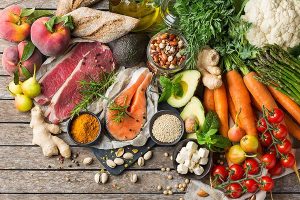A Dietitians Guide to Clean Eating
By Jen Scheinman
Jen Scheinman, MS, RDN is an integrative and functionally trained Registered Dietitian, with over 20 years of helping people improve their health through the foods they eat. Using real food and lifestyle design she helps her clients navigate their way towards optimal health.
 Clean eating is a style of eating where people choose foods that are in their whole, unprocessed form, as opposed to foods that are packaged, boxed, or have lengthy ingredient lists with words you can’t pronounce. Clean eating means different things to different people. Some people may think that clean eating means following the Paleo diet, while others believe it means being vegan. In truth, clean eating is much broader than a specific type of diet. It is possible to eat clean while following almost any diet plan. Consider it more of a lifestyle than just about the food you eat. If you are interested in trying it out, here is my 10-step guide to clean eating:
Clean eating is a style of eating where people choose foods that are in their whole, unprocessed form, as opposed to foods that are packaged, boxed, or have lengthy ingredient lists with words you can’t pronounce. Clean eating means different things to different people. Some people may think that clean eating means following the Paleo diet, while others believe it means being vegan. In truth, clean eating is much broader than a specific type of diet. It is possible to eat clean while following almost any diet plan. Consider it more of a lifestyle than just about the food you eat. If you are interested in trying it out, here is my 10-step guide to clean eating:
- Eat real food: This means eating foods that are in their most natural state and avoiding anything thing that is highly processed. Think whole fruit rather than gummy fruit snacks—a piece of salmon rather than fried fish sticks. You get the point.
- Eat more plants: Following a plant-based diet does not mean you have to be a vegetarian or vegan, it just means that the majority of your meals have foods from plants rather than animals. If you choose to consume animal products, let them take a supporting role in your meals.
- Avoid refined grains: Refined grains are those that are highly processed. Fiber, vitamins, and minerals are stripped from the grains during processing. While this makes the grains more shelf-stable, much of the nutritional value is removed. Choose whole grains instead.
- Limit added sugar: Added sugar, especially in the form of high fructose corn syrup should only be consumed in limited amounts, or better yet not at all. Multiple studies have found that added sugar wreaks havoc on your health. Sweet treats with maple syrup or honey can be enjoyed from time to time. A few clean eating proponents also recommend limiting fruit as it contains natural sugar in the form of fructose. Fruit is a fantastic source of vitamins, minerals, antioxidants, and other health-promoting phytonutrients. When eaten whole, fruit is also a great source of fiber and should be a part of a clean eating program.
- Avoid vegetable oils and spreads: You may think that oils such as corn, soy, peanut, and vegetable are healthy, but think again. These oils are highly processed and full of fatty acids that cause inflammation and may contribute to chronic disease. Choose extra virgin olive oil, avocado oil, nuts seeds, and fatty fish to balance your body’s inflammatory response.
- Select your animal products carefully: In the U.S., conventionally raised animals are given hormones banned in other countries. They are fed a diet of soy and corn as opposed to their natural diet of grass. Grass-fed beef has a higher concentration of healthy omega-3 fatty acids than conventionally fed cows.
- Limit toxin exposure: Every day, we are exposed to various toxins in the environment that our body has to filter out. These toxins enter our body from air pollution, food, water, plastics, and ingredients in our personal care products and other consumer products. Environmental toxins have been linked to several health concerns from cancer, to heart disease, to reproductive health. Limit your exposure by avoiding plastics, using cleaner personal care products, eating organic when possible.
- Read food labels: Check the ingredient list to see what’s really in a product. Look for added sugar, additives and preservatives. Just because something is labeled organic or non-GMO does not mean that it is considered a whole food or “clean”.
- Cook at home more often: When you cook at home, you know what is going into the food you eat. Restaurants often use vegetable oils, added salt, and even sugar to make it tastier. Plus, the serving sizes are usually much bigger than we would eat at home.
- Avoid the good food/bad food mentality: One of the downsides of the clean eating lifestyle is that it tends to put foods into categories of clean or not. Foods get labels like “toxic” or “bad”. Food fears and shame can develop, potentially leading to disordered eating. If the majority of your foods are nutritious and whole, having an occasional candy bar is just fine. Enjoy it, and don’t stress out about it. Just balance it out with more nutritious, clean foods.
The bottom line:
Meal plans that emphasize nutritious whole foods always get a gold star in my book. As long as it doesn’t become extreme, clean eating is a great way to eat healthy.
Jen Scheinman, MS, RDN is an integrative and functionally trained Registered Dietitian, with over 20 years of helping people improve their health through the foods they eat. Using real food and lifestyle design she helps her clients navigate their way towards optimal health.




